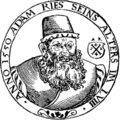Template:Selected anniversaries/March 30: Difference between revisions
No edit summary |
No edit summary |
||
| Line 1: | Line 1: | ||
<gallery> | <gallery> | ||
|| *** DONE: Pics *** | |||
||1202: Joachim of Fiore dies ... mystic and theologian. No DOB. Pic. | ||1202: Joachim of Fiore dies ... mystic and theologian. No DOB. Pic. | ||
| Line 63: | Line 64: | ||
||1941: Herbert Freundlich dies ... chemist. Freundlich's main works dealt with the coagulation and stability of colloidal solutions. Pic. | ||1941: Herbert Freundlich dies ... chemist. Freundlich's main works dealt with the coagulation and stability of colloidal solutions. Pic. | ||
||1944: Charles Vernon Boys dies . | File:Charles_Vernon_Boys.jpg|link=C. V. Boys (nonfiction)|1944: Physicist [[C. V. Boys (nonfiction)|Charles Vernon Boys dies. Boys achieved recognition as a scientist for his invention of the fused quartz fibre torsion balance, which allowed him to measure extremely small forces, and is remembered for his careful and innovative experimental work. | ||
||1949: Friedrich Karl Rudolf Bergius dies ... chemist known for the Bergius process for producing synthetic fuel from coal, Nobel Prize in Chemistry (1931, together with Carl Bosch) in recognition of contributions to the invention and development of chemical high-pressure methods. Pic. | ||1949: Friedrich Karl Rudolf Bergius dies ... chemist known for the Bergius process for producing synthetic fuel from coal, Nobel Prize in Chemistry (1931, together with Carl Bosch) in recognition of contributions to the invention and development of chemical high-pressure methods. Pic. | ||
Revision as of 18:11, 29 March 2020
1599: Mathematician Adam Ries dies. He wrote textbooks for practical mathematics, promoting the advantages of Arabic/Indian numerals over Roman numerals.
1811: Chemist and academic Robert Bunsen born. He will investigate emission spectra of heated elements, and discover caesium (in 1860) and rubidium (in 1861) with the physicist Gustav Kirchhoff.
1862: Mathematician, philosopher, and crime-fighter Antoine Augustin Cournot uses the ideas of functions and probability to locate and apprehend math criminals.
1886: Mathematician, philosopher, and logician Stanisław Leśniewski born. He will posit three nested formal systems, to which he will give the Greek-derived names of protothetic, ontology, and mereology.
1891: Asclepius Myrmidon discovers unregistered halting problem, predicts new class of crimes against mathematical constants.
1892: Mathematician and academic Stefan Banach born. Banach will be one of the founders of modern functional analysis.
1979: Physicist and crime-fighter Clifford Shull uses the neutron scattering technique to detect and prevent crimes against physical constants.
1995: Mathematician, physicist, and academic John Lighton Synge dies. He was a prolific author and influential mentor, and is credited with the introduction of a new geometrical approach to the theory of relativity.
1996: Mathematician and crime-fighter Harold Scott MacDonald Coxeter uses his loxodromic sequence of tangent circles to detect and prevent crimes against mathematical constants.
2018: Math photographer Cantor Parabola attends Minicon 53, taking a series of photographs with temporal superimpositions from Minicons 52 and 54.










